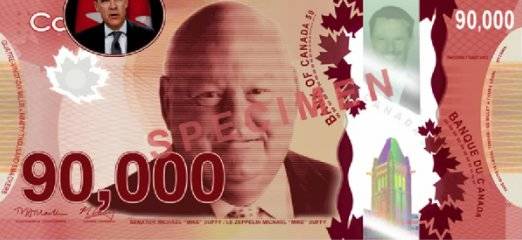Canadian Conservative senator Mike Duffy is in disgrace over the news that he submitted fraudulent expense claims totalling $90,000 and secretly borrowed a like sum from the Prime Minister's Chief of Staff to pay it (and kill an auditor's investigation into his conduct). So Dan Murphy drew an editorial cartoon depicting a notional Canadian $90,000 bill bearing Senator Duffy's leering face. But the toon only ran briefly, because the Bank of Canada threatened Canadian newspapers with criminal prosecution for counterfeiting if they ran it.
That gets to the crux of the matter. Laws that fight counterfeiting are fine (though really, any forger gifted enough to back-engineer a single-sided cartoon of a $90,000 bill that bears the image of Mike Duffy and a hologram of Nigel Wright deserves a medal, not jail time) but the Bank of Canada has no business playing Thought Police.
Parodies of bank notes are nothing new. In 1819, British cartoonist George Cruikshank, angered after seeing a woman hanged for passing a forged note, drew a Bank of England note that featured 11 men and women dangling from nooses. During the currency panic of 1837, a series of “shin plasters” — typically five- and six-cent bills — poked fun at U.S. economic policy.
Original Article
Source: boingboing.net
Author: Cory Doctorow
That gets to the crux of the matter. Laws that fight counterfeiting are fine (though really, any forger gifted enough to back-engineer a single-sided cartoon of a $90,000 bill that bears the image of Mike Duffy and a hologram of Nigel Wright deserves a medal, not jail time) but the Bank of Canada has no business playing Thought Police.
Parodies of bank notes are nothing new. In 1819, British cartoonist George Cruikshank, angered after seeing a woman hanged for passing a forged note, drew a Bank of England note that featured 11 men and women dangling from nooses. During the currency panic of 1837, a series of “shin plasters” — typically five- and six-cent bills — poked fun at U.S. economic policy.
Original Article
Source: boingboing.net
Author: Cory Doctorow

No comments:
Post a Comment